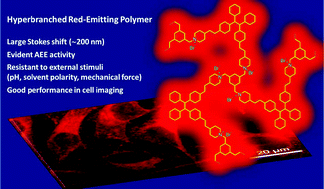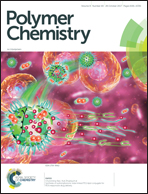A red-emitting cationic hyperbranched polymer: facile synthesis, aggregation-enhanced emission, large Stokes shift, polarity-insensitive fluorescence and application in cell imaging†
Abstract
We report the synthesis and properties of a cationic hyperbranched polymer containing tetraphenylethene (TPE) and pyridinium moieties. The polymerization was efficient under mild conditions (60 °C, 12 h) and the yield was as high as 92%. Due to the existence of the TPE moieties, the polymer exhibits an evident aggregation-enhanced emission (AEE) property, and the fluorescence quantum yield is 13.5% and 6.5% as a solid and in a dilute solution, respectively. The conjugation of TPE with the pyridinium moieties bestows the hyperbranched polymer with an extremely large Stokes shift of over 200 nm, and low susceptibility to external stimuli such as mechanical grinding in solid, solvent polarity in solution, and pH change in aqueous medium. The cationic characteristic gives the red-emitting polymer good membrane permeability, and the results of living cell stain experiments suggest that it may find applications as a stable fluorescent probe for bioimaging.



 Please wait while we load your content...
Please wait while we load your content...